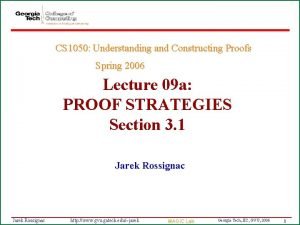Trigonometry ID 1050 Quantitative Qualitative Reasoning Triangle and








- Slides: 8

Trigonometry ID 1050– Quantitative & Qualitative Reasoning

Triangle and Definitions • Trigonometry is the study of the ratios of the sides of a right triangle. • One of the angles that isn’t the 900 angle is labeled x. • The sides of the triangle are labeled relative to x: • Adjacent (a) • Opposite (o) • Hypotenuse (h) e s u n ote hyp x adjacent opposite

Interactive Simulation • This simulation illustrates the geometric relationship between the trigonometry functions and the right triangle. Some things to note: • • You can select sin, cos, and tan You can choose degrees or radians The angle and the function value are shown to the left. You can display the graph of the function versus angle (at the bottom). The connection between the triangle and the graph is shown by the red dot https: //phet. colorado. edu/en/simulation/trig-tour

Examples: Evaluation • The trigonometry functions are unary functions. • They take a single argument (number), which is an angle, usually specified in either ----- degrees or radians. PEMDAS Parentheses Exponents Multiplication Division Addition Subtraction • Examples: • Sin(30 o)=0. 5 • Cos(30 o)=0. 866… • Tan(45 o)=1 • In the order of operations, the trigonometry functions fall between Parentheses and Exponents • See the TI-30 Xa calculator tutorial, or the manual for your calculator, to determine exactly how to enter these functions and to choose the angle mode.

Inverse Trigonometric Functions • Each trigonometry functions has its own inverse • • • Sine is inverted by the inverse sine, sin-1 (also called arc-sine, anti-sine, or asin) • The inverse functions are also unary functions. They take a single argument (number), and return an angle. Cosine is inverted by the inverse cosine, cos-1 (also called arc-cosine, anti-cosine, or acos) Tangent is inverted by the inverse tangent, tan-1 (also called arc-tangent, anti-tangent, or atan) • Calculators often use the same button for both a function and its inverse. The inverse function is usually accessed by first hitting the ‘ 2 nd’ button, then the function button. Sine Inverse Sine

Inverse Trigonometric Functions • In the order of operations, the inverse trigonometry functions also fall between Parentheses and Exponents • Evaluation examples: • Sin-1(0. 5)=30 o [ because Sin(30 )=0. 5 ] • Cos-1 (0. 866)= 30 o [ because Cos(30 )=0. 866 ] • Tan-1 (1)= 45 o [ because Tan(45 )=1 ] o o o ----- PEMDAS Parentheses Exponents Multiplication Division Addition Subtraction

Solving Equations: Single Function • To solve an equation for an unknown variable that is affected by only one trigonometry operation, you must apply the inverse of that operation to both sides of the equation. • The operation and its inverse ‘cancel each other’, leaving just the unknown on one side, and its value on the other. • Example: sin(x)=0. 5 • • • The operation affecting ‘x’ is ‘sine’ or sin(). Its inverse is ‘inverse sine’ or sin-1(). Taking the inverse sine of both sides yields: sin-1( sin(x) ) = sin-1( 0. 5 ) x = 30 o Example: tan-1(x) = 16 • • The operation affecting ‘x’ is ‘inverse tangent’ or tan-1(). Its inverse is ‘tangent’ or tan(). Taking the tangent of both sides yields: tan( tan-1(x) ) = tan( 16 ) x = 0. 287

Conclusion • Trigonometry is the study of the relationship between angles and sides of a right triangle. • There are three important functions: sine, cosine, and tangent. • Each function has an inverse.















